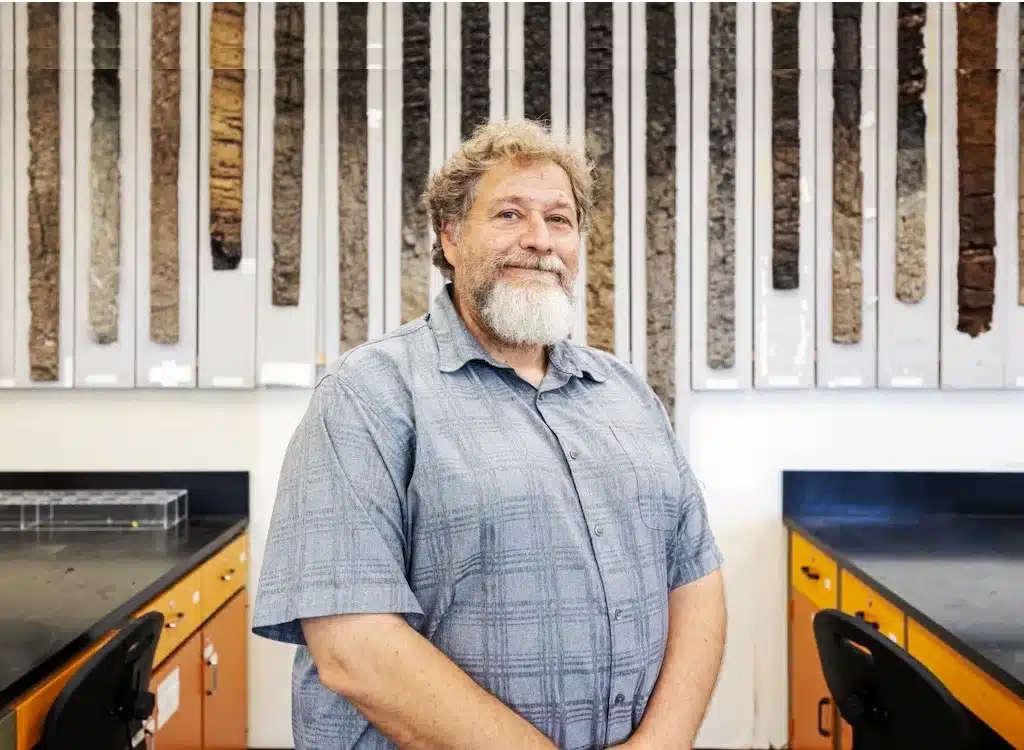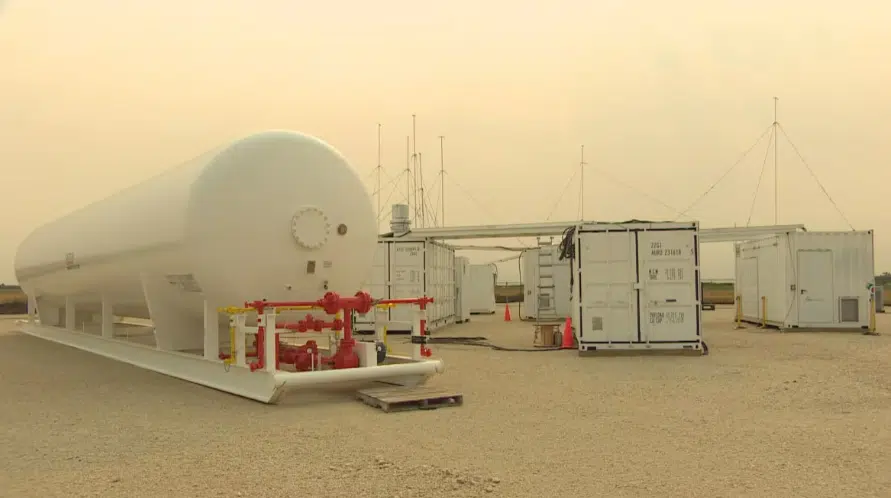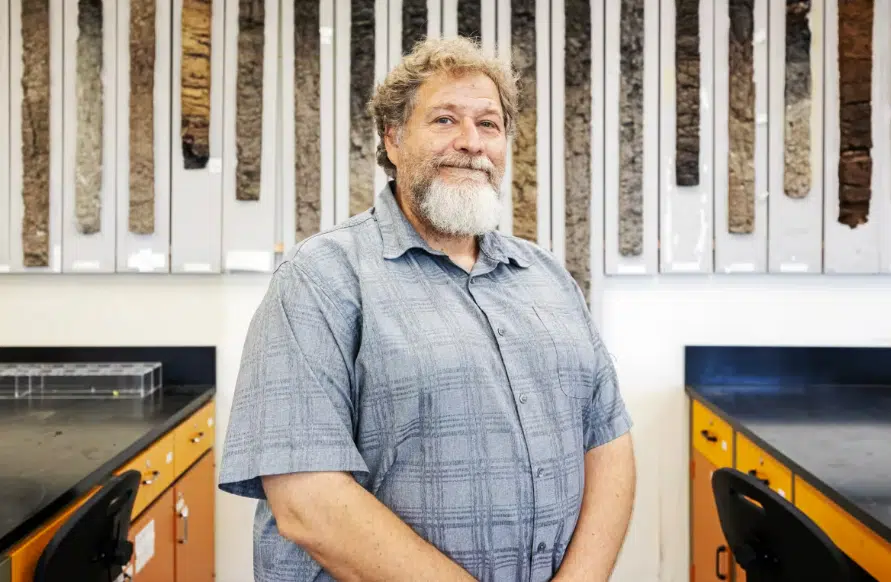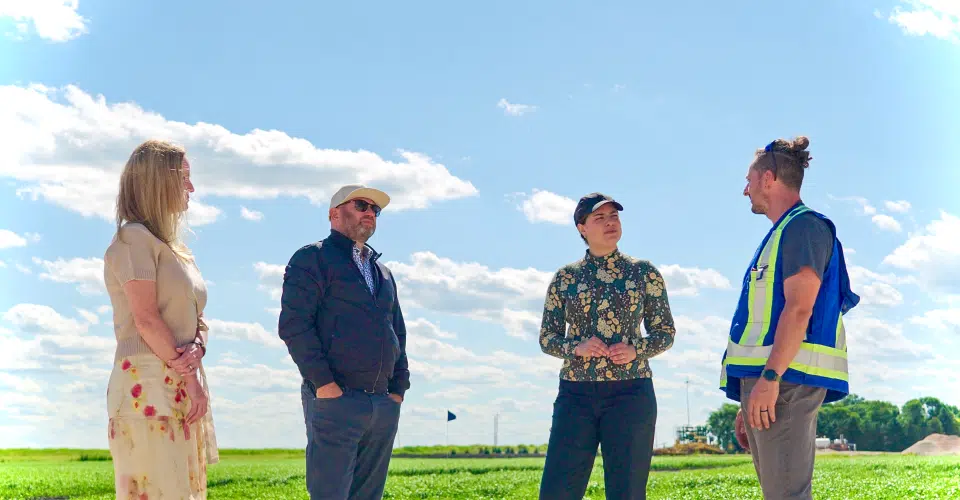
Green ammonia a potential game changer in agriculture, says Manitoba farmer
CBC News ·

Curtis Hiebert explaining the process of making green ammonia.
A Manitoba farmer says he’s hopeful a new technology being tested on his land could change the face of agriculture not only in this province, but across Canada.
One of the main ingredients required for farming is anhydrous ammonia, which is used for nitrogen fertilizer, says Curtis Hiebert, who is the operator of R & L Acres and has been farming since he was 12.
“Nitrogen is in the air all around, and the process of anhydrous production is pulling that nitrogen out of the air, and putting it into a form that we can put into the ground,” he said.
Roughly 80 per cent of the world’s ammonia is used in the agriculture sector for fertilizer.
But because the process for making traditional ammonia involves removing hydrogen from fossil fuels like crude oil, methane and coal, it has significant environmental impacts. It’s an energy intensive process that produces around 1.8 per cent of global carbon dioxide emissions.
But a new process for making ammonia aims to change that. It involves making ammonia in a unit called a containerized green ammonia production system, and the end result is carbon-free ammonia created without using fossil fuels.
The system is set up on site at a farm, which gives ag producers like Hiebert more control over his ammonia supply.

The containerized green ammonia production system is set up on site at a farm, which gives ag producers like Hiebert more control over his ammonia supply. (Justin Fraser/CBC)
“Bringing it on site, then we know it’s here — it doesn’t need to be transported from Brandon or Saskatchewan, where these anhydrous [ammonia] plants are,” said Hiebert.
“Hopefully [this will] remove some of the volatility in the price of the product as well.”
The containerized production system was created by a Canadian company called FuelPositive.
Its CEO, Ian Clifford, said what’s referred to as “green ammonia” is made by using electricity to remove hydrogen from water. It’s then combined with nitrogen from the air to make ammonia. The green ammonia is stored on site in a container for the farmer to use as needed.
“The most important ingredient to green ammonia is the fact that you got to start with a carbon-free, sustainable form of electricity. So one of the reasons we’re starting all of this in Manitoba is specifically because it’s a green grid — it’s low-cost electricity,” since the province relies heavily on hydro electricity, said Clifford.

A diagram from the company FuelPostive shows how the containerized green ammonia production system works. (FuelPositive)
Ammonia, and the fertilizer it produces, are essential parts of feeding the planet, but the way it’s made now creates a huge carbon burden on the environment. Decentralizing ammonia production by making it possible on farms is “a paradigm shift,” he said.
“We can’t handle centralized production — we can’t handle that level of carbon intensity, and it doesn’t make sense to move a molecule thousands and thousands of kilometres, when in fact the end user can produce it and utilize it on farm.”
The containerized green ammonia production system is controlled remotely, and FuelPositive will monitor the system, so it won’t add to an ag producer’s workload, said Clifford. All the producers have to do is apply it.
Clifford plans to build the company’s ammonia production systems in Manitoba, and expects to be filling orders in the coming weeks and months.
“Green ammonia is very exciting,” said Mario Tenuta, a professor of soil ecology at the University of Manitoba.
He said ammonia has been made the same way for a hundred years, but the new process sets a path toward using renewables in agriculture.
“When you start thinking about technologies and approaches that get us towards a point in time where we’re not changing the atmosphere or our environment to the negative, that is really good,” said Tenuta.
“We know we need to get there, we know the atmosphere can’t be changing forever. Things will start to run away on us in terms of nature’s checks and balances on climate and temperature.”

The potential for green ammonia is ‘very exciting,’ says Mario Tenuta, a professor of soil ecology at the University of Manitoba. (Prabhjot Singh Lotey/CBC)
Tenuta said making green ammonia will reduce emissions related to making food overall, and the cascading effects of that will appeal to major food processors and retailers.
“It’s shaving away … emissions of greenhouse gasses from products and things that they buy from someone else,” said Tenuta.
“It’s very enticing for them, so this technology and this approach is being watched very carefully by many different groups in our food system.”
-
CBC Explains
Hiebert said the benefit to the environment, along with the economic benefits and being in control of his own ammonia supply, are all wins for him and his farm.
“We should know what the price [of ammonia] is for the next 15 to 20 years — the life of the plant, which I’m told is a long time,” said Hiebert.
“If we can be off the grid, I don’t have to worry about the price of [fossil fuels], so that’s a huge benefit to us.
About FuelPositive Corporation
FuelPositive is a Canadian technology company dedicated to delivering commercially feasible and sustainable clean technology solutions that follow a circular approach, ensuring the entire lifecycle of our products is environmentally friendly. This includes an on-farm/onsite, containerized Green Ammonia (NH3) production system that effectively eliminates carbon emissions during the production process.
By focusing on technologies that are clean, sustainable, economically advantageous and realizable, the Company aims to help mitigate climate change, addressing unsustainable agricultural practices through innovative technology and practical solutions that can be implemented now. The FuelPositive on-farm/onsite, containerized Green Ammonia production system is designed to produce pure, anhydrous ammonia for multiple applications, including fertilizer for farming, fuel for grain drying and internal combustion engines, a practical alternative for fuel cells and a solution for grid storage. Green Ammonia is also considered a key enabler of the hydrogen economy.
FuelPositive systems are designed to provide for Green Ammonia production on-farm/onsite, where and when needed. This eliminates wildly fluctuating supply chains and offers end-users clean fertilizer, energy and Green Ammonia supply security while eliminating carbon emissions from the production process. The first customers will be farmers. Farmers use 80% of the traditional grey ammonia produced today as fertilizer.
See sale details here: https://fuelpositive.com/sales/.
FuelPositive Corporation is based in Waterloo (Canada) and trades on the TSX Venture Exchange under the symbol NHHH and in the USA on the OTCQB under the symbol NHHHF.
To Contact FuelPositive:
Investor Relations Canada, United States & International:
Transcend Capital Inc.
Cautionary Statement
Trading in the securities of the Company should be considered highly speculative. No stock exchange, securities commission or other regulatory authority has approved or disapproved the information contained herein. Neither the TSX Venture Exchange nor its Regulation Services Provider (as that term is defined in the policies of the TSX Venture Exchange) accept responsibility for the adequacy or accuracy of this release.
Forward-Looking Statements
This news release contains certain “forward-looking information” and “forward-looking statements” (collectively, “forward-looking statements”) that are based on expectations, estimates and projections as of the date of this news release. The information in this release about future plans and objectives of the Company, including with respect to further testing and implementation of the FP300 system, are forward-looking statements.
These forward-looking statements are based on assumptions and estimates of management of the Company at the time they were made and involve known and unknown risks, uncertainties and other factors which may cause the actual results, performance or achievements of the Company to be materially different from any future results, performance or achievements expressed or implied by such forward-looking statements. Forward-looking statements are necessarily based upon a number of estimates and assumptions that, while considered reasonable by the Company as of the time of such statements, are inherently subject to significant business, economic and competitive uncertainties and contingencies. These estimates and assumptions may prove to be incorrect.
Many of these uncertainties and contingencies can directly or indirectly affect and could cause, actual results to differ materially from those expressed or implied in any forward-looking statements. There can be no assurance that forward-looking information will prove to be accurate, as actual results and future events could differ materially from those anticipated in such statements.
Forward-looking information is provided for the purpose of providing information about management’s expectations and plans relating to the future. The Company disclaims any intention or obligation to update or revise any forward-looking information or to explain any material difference between subsequent actual events and such forward-looking information, except to the extent required by applicable law.





